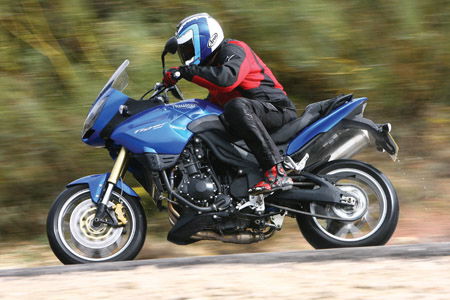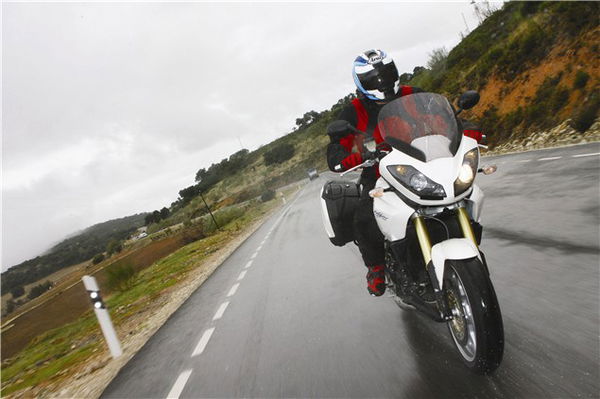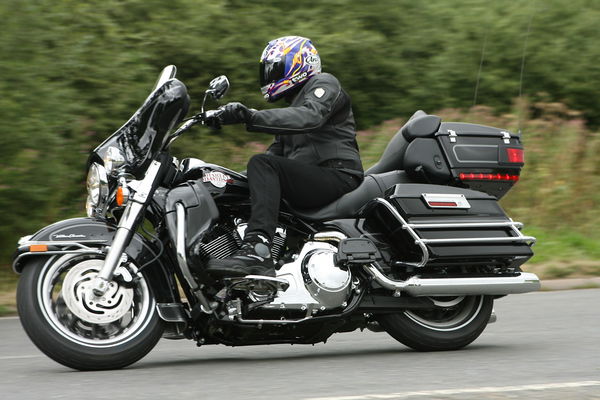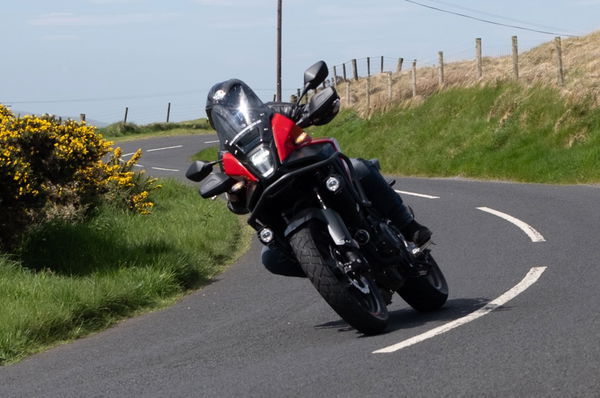First Ride: 2006 Triumph Tiger 1050
Triumph's Tiger sheds the big trailie looks, sharpens its claws and goes for a more road-inspired image. Is this the right direction for Hinckley's big cat?

 |
Click here to read: Triumph Tiger 1050 owners reviews,,
Triumph Tiger 1050 specs,
and see the Triumph Tiger 1050 image gallery.
The beautiful planet we all live on is falling apart. Seas are rising, icecaps are melting and pandas are having trouble getting it up. Global warming is to blame: we're burning too much fuel, creating too many pollutants and allowing cows to fart unhindered. All of which is causing Mother Earth to get a bit hot under the collar.
Except as far as I can tell it's all nonsense because from the moment we landed in Spain for the launch of Triumph's new Tiger 1050 the heavens opened and it didn't stop raining until we left.
And that means this is less of a comprehensive first test and more of a first impression. Sorry, but the weather really was that bad and I wouldn't like to even pretend I pushed things that hard. At all.
So what are those first impressions? For a start the new 1050 motor is simply beautiful. Compared to the old Tiger's 955cc motor the new lump - which is the same as that used in the Speed Triple and Sprint ST, but with a taller top gear and different air box and ECU - is a massive leap forward. It pulls cleanly from as low as 1500rpm and feels much stronger than that old 955i engine. It really suits this style of bike. Big trailie owners (okay, I know, the Tiger isn't really a big trailie anymore, but bear with me) in the main want motors that deliver smooth power and strong low-down torque, which is ideal for touring on all types of roads, one- or two-up and usually with luggage. Most manufacturers satisfy this need by using a big
V-twin motor, but to avoid the twin's inherent lumpiness we're often left with a dull, characterless engine (think Honda Varadero). Triumph's 1050 triple motor manages to provide bags of torque while still retaining loads of character.
And with a claimed 113bhp and 74lb.ft of torque the Tiger should have more than enough power for solo or two-up trips, while the fuel injection is smooth enough to help prevent pillions head-butting riders every time the throttle is opened - that is until the rider changes gear. Unfortunately, you see, the gearbox is also straight from the Speed Triple, which means it's far from super slick, clunks into gear and generally feels agricultural.
Anyway, back to the 'what the new Tiger actually is' issue. For 2007 Triumph has given the bike a complete ground-up, rebuild. This is a totally new bike, not an updated 2006 Tiger, so it has a new frame, seat, tank, suspension and, at last, 17-inch wheels. Which means it's no longer a big trailie as it doesn't have a tall, skinny off-road derived front wheel and tyre. But it isn't really a big supermoto either. So what is it? It's a manufacturer finally seeing sense, that's what.
This has long been a bugbear of mine. With the possible exception of a few BMW GSs, big 'trailie' owners don't take their bikes off-road. When was the last time you saw a V-Strom belting along a fire-track? Exactly. It doesn't happen, so why give them off-road style odd-sized wheels and tyres that don't offer as much grip as 17-inch road tyres? It's a ridiculous style over function statement.
So with its new, 17-inch wheels the Tiger feels much more planted and reassuring on the road. Again, because of the weather I didn't really push hard, but even in the wet the new Tiger feels like a gigantic leap forward. The road rubber provides much more positive feedback than pseudo-knobbly rubber, while subtle changes to the Tiger's geometry, not to mention its 17-kilo weight-loss, help it turn far faster.
One change I'm not 100 per cent sure about are the new radial brakes. Although they look visually identical to the Speed Triple's set-up, the Tiger has a larger bore master cylinder to reduce the power a bit and give better feeling. Yet I found they lacked feel, which has a lot to do with the braided steel lines. Compared to rubber lines they have a very direct, firm feel without the initial slight squidge you get with rubber hoses, and there's very little lever movement between the initial bite and full-on. I'd prefer to sacrifice a little bite for more feel. And if you're interested, an ABS version will be out in early 2007.
Triumph has done a lot of work to make the new Tiger a more rider-friendly bike, and it has some excellent features. The tank is metal rather than plastic, so magnetic tank bags can be used. Good. The instruments now have a fuel gauge, trip meters, miles to reserve and miles per litre display and the superbly padded and comfortable seat is narrower to allow shorter riders to get their feet closer to the ground. Plus the Triumph range of extras includes a taller screen, gel seat and panniers - all features aimed at allowing riders to get the most from their bike. My only complaint is that the panniers are fiddly and difficult to close properly.
My initial impression is that the new Tiger hits the nail on the head, and it's what a big trailie should be. The new chassis and wheels makes it a far better handling bike than the big wheeled big trailie/adventure tourer competition, the 1050 motor is beautiful and I love the styling. It will match the competition with a close to 200-mile tank range, is as comfortable, offers as much weather protection and is a match on price. The only thing that may put some buyers off is the perception of an overtly sporty image. Yes, it looks sporty, but the Tiger, for me at least, is the perfect big trailie.
VERDICT 5/5
The gearbox and fiddly panniers are annoying, but the new Tiger looks set to be a great road bike
SPECS
TYPE - ALL ROUNDER
PRODUCTION DATE - 2007
PRICE NEW - £7499 / £8099 WITH ABS
ENGINE CAPACITY - 1050cc
POWER - 114bhp@9400rpm
TORQUE - 74lb.ft@6250rpm
WEIGHT - 198kg
SEAT HEIGHT - 835mm
FUEL CAPACITY - 20L
TOP SPEED - 145mph
0-60 - n/a
TANK RANGE - N/A

The beautiful planet we all live on is falling apart. Seas are rising, icecaps are melting and pandas are having trouble getting it up. Global warming is to blame: we're burning too much fuel, creating too many pollutants and allowing cows to fart unhindered. All of which is causing Mother Earth to get a bit hot under the collar.
Except as far as I can tell it's all nonsense because from the moment we landed in Spain for the launch of Triumph's new Tiger 1050 the heavens opened and it didn't stop raining until we left.
And that means this is less of a comprehensive first test and more of a first impression.
Sorry, but the weather really was that bad and I wouldn't like to even pretend I pushed things that hard. At all.
So what are those first impressions? For a start the new 1050 motor is simply beautiful. Compared to the old Tiger's 955cc motor the new lump - which is the same as that used in the Speed Triple and Sprint ST, but with a taller top gear and different air box and ECU - is a massive leap forward. It pulls cleanly from as low as 1500rpm and feels much stronger than that old 955i engine. It really suits this style of bike.
Big trailie owners (okay, I know, the Tiger isn't really a big trailie anymore, but bear with me) in the main want motors that deliver smooth power and strong low-down torque, which is ideal for touring on all types of roads, one- or two-up and usually with luggage. Most manufacturers satisfy this need by using a big V-twin motor, but to avoid the twin's inherent lumpiness we're often left with a dull, characterless engine (think Honda Varadero). Triumph's 1050 triple motor manages to provide bags of torque while still retaining loads of character.
And with a claimed 113bhp and 74lb.ft of torque the Tiger should have more than enough power for solo or two-up trips, while the fuel injection is smooth enough to help prevent pillions head-butting riders every time the throttle is opened - that is until the rider changes gear. Unfortunately, you see, the gearbox is also straight from the Speed Triple, which means it's far from super slick, clunks into gear and generally feels agricultural.











